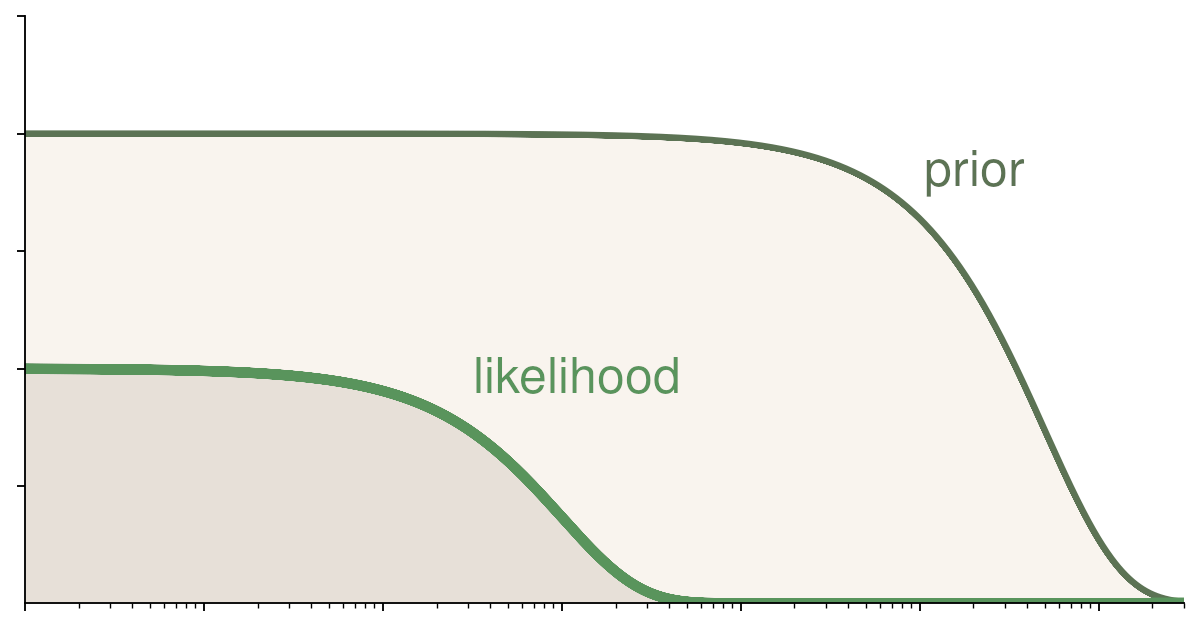
Let's assume you observed a Poisson process for a certain duration $t$ and you observed $x$ occurrences within $t$. What does this tell you about the rate $\lambda$ of the underlying Poisson process? An unbiased point estimate $\widehat{\lambda}$ for $\lambda$ is:
$$
\lambda \approx \widehat{\lambda} = \frac{x}{t}\,.
$$ Even though the estimate $\widehat{\lambda}$ is unbiased, its value can vary considerably for different experiments, especially if $t$ is small.
Posterior distribution for the rate $\lambda$
The (posterior) uncertainty about the rate $\lambda$ can be quantified using a Bayesian approach: It can be expressed as a Gamma distributed random variable with shape parameter $k^{\prime\prime}=x+k^\prime$ and rate parameter $\nu^{\prime\prime}=t+\nu^\prime$, where $k^\prime$ and $t^\prime$ are the corresponding parameters of the prior distribution. The (posterior) probability density function of $\lambda$ is then:
$$
f_{\lambda|x,t}(\lambda) = \frac{\nu^{\prime\prime}\cdot\left(\nu^{\prime\prime}\lambda\right)^{k^{\prime\prime}-1}}{\Gamma\left(k^{\prime\prime}\right)} \cdot \exp\left(-\nu^{\prime\prime}\lambda\right)\,,
$$ where $\Gamma(\cdot)$ denotes the gamma function defined as $\Gamma(k) = \int_0^\infty z^{k-1}\exp(-z)\,\mathrm{d}z$.
The posterior mean of $\lambda$ is:
$$
\operatorname{E}\left[\lambda|x,t\right] = \frac{k^{\prime\prime}}{\nu^{\prime\prime}}=\frac{x+k^{\prime}}{t+\nu^{\prime}}\,.
$$ The posterior variance of $\lambda$ is.
$$
\sigma\left[\lambda|x,t\right] = \frac{\sqrt{k^{\prime\prime}}}{\nu^{\prime\prime}}=\frac{\sqrt{x+k^{\prime}}}{t+\nu^{\prime}}\,.
$$ The posterior coefficient of variation of $\lambda$ is.
$$
\delta_{\lambda|x,t} = \frac{1}{\sqrt{k^{\prime\prime}}}=\frac{1}{\sqrt{x+k^{\prime}}}\,.
$$
Underlying prior distribution for $\lambda$
The prior distribution underlying the posterior distribution stated above is a Gamma distribution with shape parameter $k^\prime$ and rate parameter $\nu^\prime$. Working with $k^\prime=1$ and $\nu^\prime=2$ is commonly a robust choice. These prior parameters are particularly suitable to quantify upper credible intervals for $\lambda$.
Credible intervals for $\lambda$
Based on the posterior distribution stated in the previous section, credible intervals can be evaluated. Upper credible intervals are of particular relevance to quantify the uncertainty about the rate $\lambda$ of the Poisson process in many engineering applications, as they quantify how plausible it is that the value of $\lambda$ is smaller than an associated upper bound. For example, the $95\%$ upper credible interval gives the threshold $u_{95\%}$, for which there is a $95\%$ probability that the value of $\lambda$ is smaller than $u_{95\%}$; i.e., $\Pr\left[\lambda\le u_{95\%} \right] = 95\%$. As the posterior $\lambda$ follows a Gamma distribution, it is straightforward to evaluate upper credible intervals for $P_f$. To evaluate upper credible intervals for the Poisson process, our Online Tool for the post-processing of a Poisson process can be used.
Illustrative example: For example, if we observed 3 occurrences within $10^4$ hours, there is a $95\%$ probability that the value of $\lambda$ is smaller than $7.75\cdot 10^{-4}$ occurrences per hour. ■
The presented Bayesian approach gives you meaningful credible intervals even for the case when no occurrences were observed; i.e., for $x=0$.
Illustrative example: For example, if we observed no occurrences within $10^4$ hours, there is a $95\%$ probability that the value of $\lambda$ is smaller than $3\cdot 10^{-4}$ occurrences per hour. ■
+49 (0)89 21709083
